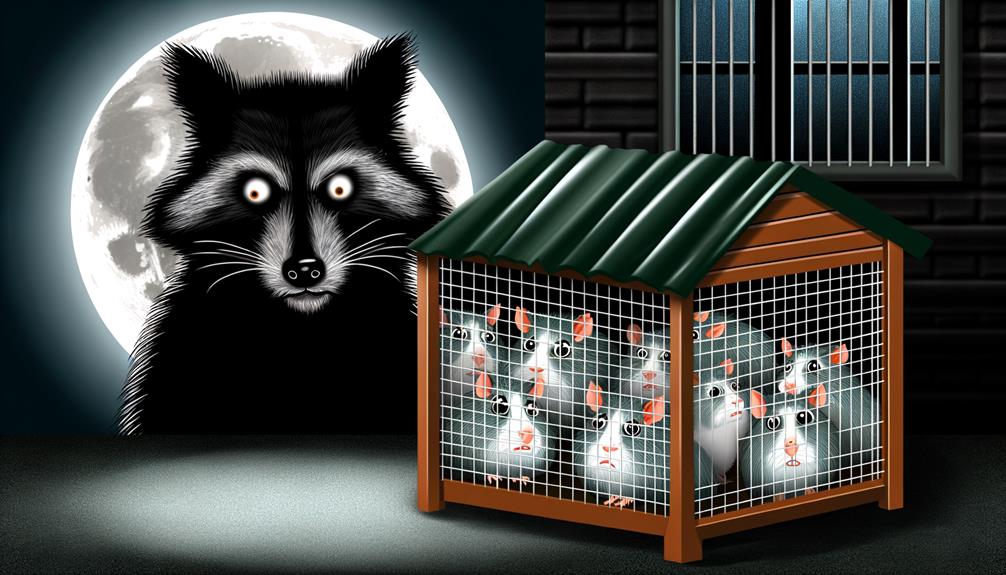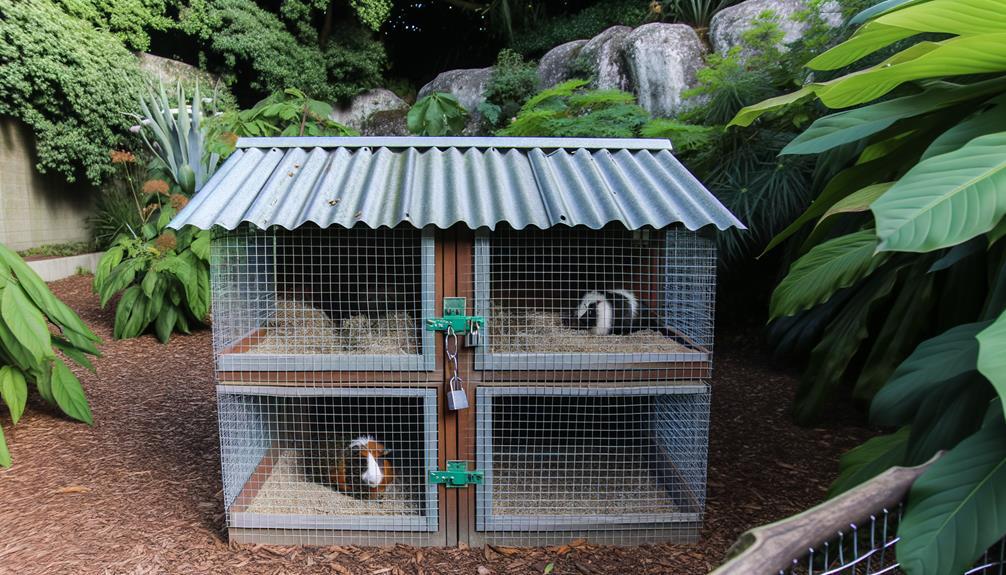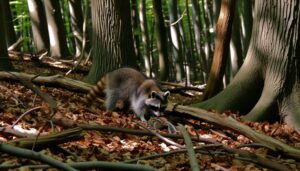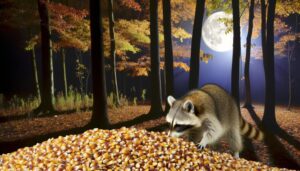Do Raccoons Eat Guinea Pigs: How to Keep Them Away
Raccoons, with their omnivorous and opportunistic diet, can indeed pose a threat to guinea pigs, especially in outdoor environments. Their diet includes small mammals, making guinea pigs vulnerable due to their size and limited escape abilities.
Raccoons are nocturnal, increasing the risk of predation during night-time when guinea pigs are enclosed outside. Habitats of both species often overlap in suburban and rural areas, where raccoons forage for food and guinea pigs reside in enclosures.
Ensuring secure, predator-resistant housing and vigilant monitoring can mitigate these risks. For further insights on protective measures and signs of raccoon presence, keep exploring.

Key Takeaways
- Raccoons are omnivores and may eat guinea pigs if they encounter them.
- Guinea pigs' small size and limited agility make them easy prey for raccoons.
- Raccoons forage opportunistically and will attack small vertebrates, including guinea pigs.
- Nocturnal raccoons might invade outdoor guinea pig enclosures at night.
- Secure, predator-resistant housing is essential to protect guinea pigs from raccoon attacks.
Raccoons' Natural Diet

Raccoons (Procyon lotor) mainly have an omnivorous diet, which includes a variety of fruits, nuts, insects, and small vertebrates. This dietary flexibility allows raccoons to adapt to diverse environments, ranging from urban areas to dense forests.
Their foraging behavior is opportunistic, often dictated by seasonal availability of food sources. In spring and summer, raccoons mostly consume fruits, berries, and insects, which are abundant during these periods. In contrast, autumn diets shift towards nuts and seeds, essential for fat accumulation prior to winter.
Additionally, raccoons consume small vertebrates like amphibians, birds, and rodents, supplementing their nutritional requirements. This varied diet underscores the raccoon's ability to exploit a wide range of ecological niches, contributing to their widespread distribution.
Predatory Behavior of Raccoons
Raccoons exhibit natural hunting instincts that enable them to be opportunistic predators, capable of adapting to various environments. Their common prey preferences include small mammals, birds, amphibians, and insects, which they hunt using their sharp senses and nimble front paws.
Understanding these predatory behaviors is essential in evaluating the potential threat raccoons may pose to guinea pigs.
Natural Hunting Instincts
How do the natural hunting instincts of raccoons influence their predatory behavior towards small animals like guinea pigs?
Raccoons exhibit highly adaptive predatory behaviors driven by their omnivorous diet and opportunistic nature. Their keen sense of smell, tactile dexterity, and nocturnal habits make them proficient hunters, especially in environments where small animals are present.
- Keen Sense of Smell: Raccoons can detect food sources from significant distances, aiding in the location of prey.
- Tactile Dexterity: Their highly sensitive front paws allow them to manipulate objects and capture small animals with precision.
- Nocturnal Activity: Being mainly active at night, raccoons exploit the vulnerability of nocturnal and crepuscular prey.
- Opportunistic Feeding: Raccoons adapt to available food sources, enhancing their ability to target various prey, including guinea pigs.
Common Prey Preferences
The dietary patterns of raccoons reveal a preference for a diverse range of prey, encompassing insects, small mammals, birds, and amphibians, driven by their omnivorous and opportunistic nature. Their diet is heavily influenced by seasonal availability and habitat type.
In urban environments, raccoons often scavenge garbage, while in more natural settings, they hunt for live prey. Studies show that small mammals, such as mice and voles, constitute a significant portion of their diet. Additionally, raccoons exploit nesting birds and consume both eggs and chicks. Amphibians and insects, particularly during warmer months, are also essential food sources.
This adaptability in prey selection underscores their success in various ecosystems, highlighting their flexible feeding strategies.
Guinea Pigs' Vulnerabilities

Guinea pigs exhibit several vulnerabilities that can make them susceptible to predation and environmental stresses. Primarily, their small size and lack of defensive mechanisms render them easy targets for various predators.
Additionally, guinea pigs have limited speed and agility, which hampers their ability to escape from threats effectively. Their dependence on specific environmental conditions, such as stable temperatures and adequate shelter, further exacerbates their vulnerability.
- Small size: Easy prey for larger animals.
- Limited speed and agility: Ineffective at escaping predators.
- Lack of defensive mechanisms: No significant means of self-defense.
- Environmental dependence: Susceptible to adverse conditions like extreme temperatures and inadequate shelter.
These factors collectively highlight why guinea pigs are highly vulnerable in both natural and domestic environments.
Common Raccoon Prey
Given the vulnerabilities of guinea pigs, it becomes important to examine the dietary habits of raccoons to understand the potential threats they might pose.
Raccoons are omnivorous, consuming a varied diet that includes fruits, nuts, insects, small mammals, and amphibians. Their opportunistic feeding behavior enables them to exploit a wide range of food sources, adapting to seasonal availability.
Common prey items include mice, voles, frogs, and bird eggs. Additionally, raccoons are known to scavenge, which enhances their ability to survive in diverse environments. Their foraging skills are complemented by dexterous front paws, allowing them to manipulate objects and access food in complex settings.
Understanding these dietary preferences is important for evaluating the risk raccoons may pose to guinea pigs.
Habitat Overlap

Raccoons and guinea pigs may experience habitat overlap in suburban and rural areas where human households and gardens are prevalent. This overlap primarily occurs because both species are drawn to environments that provide food, shelter, and safety. Raccoons are highly adaptable and can thrive in various settings, including:
- Backyards with accessible pet food or trash cans
- Gardens with abundant vegetation and insects
- Residential areas with attics or crawl spaces for nesting
- Wooded areas adjacent to human habitation
Guinea pigs, although domesticated, might be kept outdoors in hutches, making them vulnerable to raccoon encounters.
Understanding these overlapping habitats is important for pet owners to mitigate potential risks and guarantee the safety of their guinea pigs from raccoon predation.
Nocturnal Activity Patterns
Due to their nocturnal nature, raccoons are most active during the night, which increases the likelihood of encounters with guinea pigs that may be kept in outdoor enclosures. This nocturnal activity pattern is driven by several factors including predator avoidance, temperature regulation, and foraging behavior. Raccoons use the cover of darkness to search for food, which can include small mammals like guinea pigs, if accessible. To better understand the temporal activity patterns of raccoons versus guinea pigs, the following table presents a comparative overview:
| Species | Activity Period | Key Behaviors at Night |
|---|---|---|
| Raccoons | Nocturnal | Foraging, predator evasion |
| Guinea Pigs | Crepuscular/Diurnal | Resting, minimal movement |
These patterns highlight the increased risk to guinea pigs during raccoon foraging hours.
Signs of Raccoon Presence

Identifying signs of raccoon presence is vital for evaluating potential risks to guinea pigs.
Key indicators include:
- Nocturnal activity patterns
- Distinctive tracks and droppings
- Frequently disturbed trash bins
Each of these signs provides valuable information on the likelihood of raccoons inhabiting the area.
Nighttime Activity Patterns
Frequently active during the night, Procyon lotor (commonly known as raccoons) exhibit distinct behaviors and leave identifiable signs that can be meticulously studied to confirm their presence. Their nocturnal habits make them elusive, but several indicators reveal their activity patterns.
Key signs include:
- Disturbed Trash Cans: Raccoons often forage for food in garbage, leaving bins overturned.
- Scattered Food Scraps: Remnants of their meals, such as fruit peels or food packaging, are frequently found.
- Nocturnal Vocalizations: Raccoons are known for their various sounds, including growls, purrs, and screams.
- Damaged Garden Plants: Evidence of digging or partially eaten plants can indicate raccoon foraging.
These signs can help homeowners and researchers identify raccoon activity in specific areas.
Tracks and Droppings
Understanding the nocturnal behaviors of raccoons is further improved by examining the tracks and droppings they leave behind. Raccoon tracks are distinctive, resembling small human hands with five elongated fingers. These tracks are usually found near water sources, as raccoons frequently forage in such areas.
Droppings, or scat, provide additional evidence of raccoon presence. Raccoon scat is tubular, often segmented, and typically ranges from 2 to 3 inches in length. It may contain remnants of their diverse diet, such as seeds, berries, and insect exoskeletons. Analyzing these signs not only confirms raccoon activity but also offers insights into their feeding habits and habitat preferences.
Recognizing these indicators is vital for those monitoring wildlife impact on small pets like guinea pigs.
Disturbed Trash Bins
One of the most telling indicators of raccoon activity around human habitation is the disturbance of trash bins, which these nocturnal animals often raid in search of food. Raccoons exhibit a high level of dexterity, enabling them to open lids and rummage through waste.
Signs of raccoon presence around trash bins include:
- Scattered trash: Items strewn around the vicinity of the bin.
- Footprints: Distinctive five-toed tracks in the surrounding area.
- Damaged bins: Scratch marks and gnawed edges on plastic or metal surfaces.
- Odor: A strong, musky smell emanating from areas where raccoons frequent.
Recognizing these signs not only helps in identifying raccoon activity but also assists in implementing effective deterrents to prevent further disturbances.
Protecting Guinea Pigs
To effectively protect guinea pigs from potential predators such as raccoons, it is essential to implement secure housing and vigilant monitoring practices. Continuous supervision, particularly during nocturnal hours when raccoons are most active, is pivotal.
Installing motion-activated lights and surveillance cameras can deter raccoons and provide real-time alerts of any intrusions. Additionally, ensuring that guinea pigs' living quarters are cleaned regularly will minimize attractants like food remnants, which could lure raccoons.
It is also advisable to establish a routine for checking the integrity of fences or barriers, as raccoons are known for their dexterity and ability to exploit weaknesses. By combining these strategies, the risk to guinea pigs from predatory raccoons can be notably reduced.
Secure Housing Solutions

Implementing sturdy and safe housing solutions for guinea pigs involves utilizing resilient materials and well-designed enclosures that prevent raccoons and other predators from gaining access. Effective enclosures should be constructed from materials such as galvanized steel or heavy-duty plastic, which resist chewing and clawing. Additionally, enclosures must include secure latching mechanisms to prevent unauthorized entry.
Proper ventilation should be guaranteed without compromising security, to maintain a healthy environment for guinea pigs.
Key elements to ponder include:
- Material Strength: Use of durable, predator-resistant materials.
- Secure Latches: Implementation of tamper-proof locking systems.
- Ventilation: Adequate airflow without compromising structural integrity.
- Enclosure Design: Thoughtful layout that minimizes potential entry points.
These measures collectively create a safe habitat, protecting guinea pigs from potential threats.
Deterring Raccoons
To effectively deter raccoons, it is key to secure outdoor enclosures with durable materials that prevent unauthorized entry.
Additionally, eliminating accessible food sources in the vicinity can notably reduce the attraction for these scavengers.
Employing these strategies not only enhances the safety of guinea pigs but also fosters a controlled environment.
Securing Outdoor Enclosures
Ensuring the security of outdoor enclosures is essential for protecting guinea pigs from raccoon predation. Effective measures can greatly reduce the risk of raccoon intrusions. Robust enclosure design should include materials that resist chewing and clawing. Wire mesh with small gaps and solid locks can enhance the structural integrity. Additionally, securing the perimeter with deterrents can create an additional layer of protection.
Key strategies include:
- Reinforced Materials: Utilize heavy-duty wire mesh and sturdy locks.
- Elevated Placement: Position enclosures at elevated heights to discourage raccoon access.
- Motion-Activated Lights: Install lights that activate with movement to startle and deter raccoons.
- Electric Fencing: Employ low-voltage electric fencing around the enclosure perimeter.
These measures collectively fortify the safety of guinea pigs against raccoon threats.
Removing Food Sources
Minimizing the availability of food sources is a critical step in deterring raccoons from approaching guinea pig enclosures. Raccoons are opportunistic feeders, attracted to easily accessible food.
Pet owners should make sure that all pet food is stored securely indoors, preferably in metal containers to prevent raccoons from chewing through. Outdoor feeding should be avoided or closely monitored, with leftover food promptly removed.
Additionally, managing household waste by using raccoon-proof trash cans and compost bins can further reduce the risk. Bird feeders should be placed well away from guinea pig enclosures, as fallen seeds can attract raccoons.
Monitoring Pet Safety

Effective monitoring of pet safety involves consistently observing the environment for potential threats and implementing protective measures to mitigate risks. This entails a systematic approach to guarantee that guinea pigs are protected from predators like raccoons. Regularly inspecting the housing area and surroundings is imperative to identify any signs of intrusion or vulnerabilities.
Secure Enclosures: Guarantee cages and hutches are robust, with secure locks and small mesh sizes to prevent raccoon entry.
Surveillance Systems: Install motion-activated cameras or alarms to detect and deter nocturnal predators.
Environmental Management: Maintain a clean, clutter-free yard to reduce hiding spots for raccoons.
Routine Checks: Conduct daily inspections of pet enclosures and the immediate environment for any breaches or threats.
Conclusion
In the grand theater of nature, where raccoons, with their omnivorous inclinations, might occasionally find guinea pigs to be delectable amuse-bouches, the vulnerability of these small rodents is starkly evident.
The intersection of habitats only worsens the danger faced by guinea pigs. However, through the implementation of sturdy housing solutions and deterrent strategies, the safety of these pets can be notably improved.
Consequently, the stage is set for a perpetual ballet of predator and prey, mediated by human intervention.






